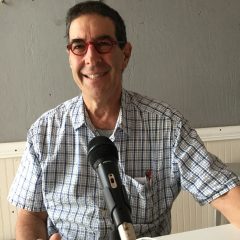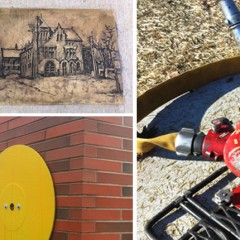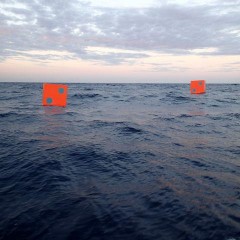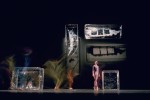Post by Max Mulhern
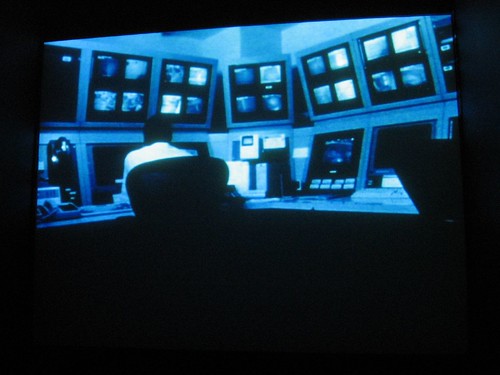
Deborah Stratman, still from In Order Not to be Here, a video about surveillance that showed a year ago at Screening Video Gallery. (All photos by Libby, unless otherwise noted).
Is the heightened state of surveillance in our world changing the way we see? I wonder because despite the exponential increase in the channels through which to diffuse art and talk about it my art seems to be increasingly invisible. Do other artists feel this way? Is there a corresponding blindness operating here as well?
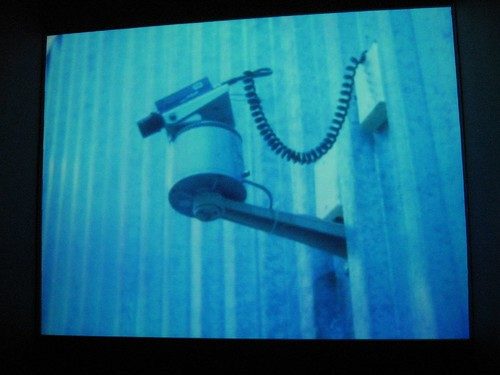
I write from the most highly surveilled area of the world (London). There seems to be a new skin to everything now, a veneer of eyes, and yet artists still spend enormous amounts of energy trying to get themselves seen. Is that still the way to go?
Yes! If you believe that you need to form a public image of yourself to your specifications that resists the dehumanizing CCTV phenomenon and counters popular culture. Otherwise, no!

Artist Ed Bronstein, taking a picture during a winery tour. We are forming our own spy network for our own lives!
I believe that surveillance and the web are twins sharing an eye. Their eye is a Gorgon “the eye which eats”. The public now sees through the same eye thus creating a kind of compound eye with compounded hungers.
These insatiable hungers creep. We hunger for privacy. We hunger for invasion of privacy as well, i.e. Facebook.
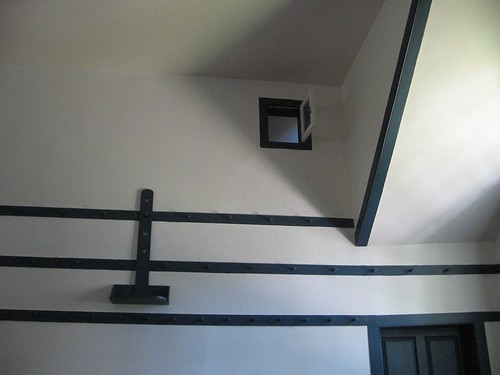
Surveillance, Shaker style, in a Shaker meeting house in Kentucky. The elders would look down at the worshippers, looking among repeat visitors for recruits to their community.
Here’s the twist. Privacy is a diminishing resource. Some IT scientists predict that by 2013 there won’t be any more privacy. The paroxysm of total visibility will be a paradox of invisibility combined with the total exposure of the self.
Our nakedness will petrify us.
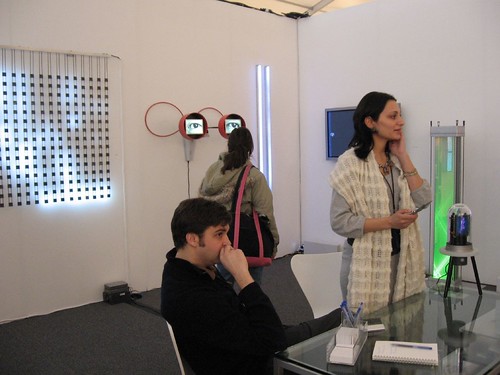
At the Bryce Wolkowitz Gallery booth at a New York art fair in 2007, lots of electronic art, including Alan Rath eyes in center and Jim Campbell minimalist light show on left. This art does look back at you!
“ . . . And red mutant eyes gazed down on hunger city . . .” I sang to myself as I looked up at the CCTV staring down at me. Should I have worn camouflage to the opening?

Red mutant eye. Image taken from product pages of scenariodreams.com
What I like most about looking at art now is that it doesn’t look back. It’s not processing me or storing anything about me. It can push my buttons but I can’t push its buttons. With objects becoming more and more « intelligent » the dumbness and deafness of art is a haven.

The monolith from 2001, A Space Odyssey, image taken from fan site www.ohgizmo.com
Yet I feel a new force coming like an old timer can feel the weather in his bones. Objects and images are resonating with a new radio-like intensity such as the monolith in Kubrick’s film “2001”. Is this because everything is being talked about on the web? Or are objects and images now possessed with the will to speak while only now momentarily lacking the necessary tools to speak?
Will objects usurp our sight? We have never seen more but we are losing sight. Scientists predict that humans will only be able to consecrate 80% of their attention at best to the world around them because of information overload. Does this mean that we will have to put less into our art in order not to overwhelm the spectator? Will this in turn fuel demand to see more work because there is always less to see per work?

McDonald’s hamburger (public domain photo). Where’s the beef?
We can’t measure the visual calories and nutrients of an image but there is a McDonald’s effect going on here. Our eyes bloat but remain hungry and malnourished. But artist aren’t starving their work. Rather the eye’s demands are depleting the nutrients. The blog tool “feed” comes to mind. Your art and electro visual persona have to practically self-replicate in order to reach critical mass. This growth has a voracious appetite for sources of form and meaning and marauds the web and the world for sustenance. The art and the artist become as hungry as the eye it is trying to feed. Result? Blindness. Blindness, along with exhaustion, famine, loss of self and loss of self worth.
Just recently Tyler Green mocked the LACMA website for asking its readers what they should be talking about on the site. This means that now art has to find a way to add value to its intrinsic value. In America that’s like adding a dime to every dollar in order to ensure that the dollar retains its original worth! What’s next, pegging art to a gold standard?
At this point I am of two minds: One says: maintain a virtual image and stay in the loop. All artists are contributing to art history. Besides, its fun to keep abreast of and contribute to the ‘hood. The other says: pull a Ulysses and blind the eye. Feed the self and not the eye otherwise we artists may disappear.
–Artist Max Mulhern, who has work up at Pageant Gallery right now (see post), last wrote for artblog about Richard Serra’s supertankers in London


